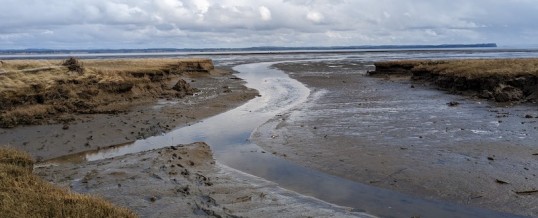
Continuing our summary of 2023 green crab status and trends
May 7, 2024
Pacific Coast
The momentum and dedication to extensive trapping for European green crab on Washington’s Pacific coastline continued to grow through 2023. Over the course of the year, nearly 355,000 green crabs were removed from the coastal estuaries and shorelines. Let’s take a closer look at what the catch data showed about population status and trends.
Newer sites with high abundances
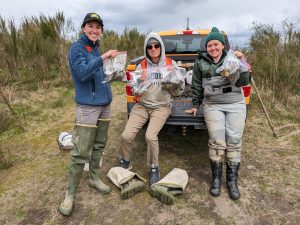
Lisa Watkins joined Nahcotta (Paul’s Slough) monitors Kim Patten and Laura Kraft (WSU Extension). The group captured 18 green crabs in 6 traps during their August 2023 sampling effort, the highest capture rate at network sites that month. Photo: Alex Stote.
As more organizations trap for green crab than ever before, we are collectively able to look in more places, with more effort and resources, than we ever have. In a few notable cases, this effort has turned up high densities of green crab at sites that were either newly trapped for the first time in 2023, or had been only lightly trapped in previous years. Some examples include the Chehalis River and Grays Harbor National Wildlife Refuge, trapped by partners at Washington Department of Fish and Wildlife (WDFW), the Grays Harbor Conservation District (GHCD), and WA Department of Natural Resources (DNR). While both of these regions had been trapped previously, increased effort revealed populations in these areas that were higher than expected.
Also in Grays Harbor, a teacher and students from Taholah High School trapped at the Quinault Marina, for the first time ever, and in doing so, shed light on an abundant population that has likely been hunkering at that site for years. Follow up intensive trapping efforts by GHCD, DNR, WDFW, and Washington Sea Grant in coordination with the Quinault Indian Nation, yielded thousands of crabs, many of which were large males with epibionts such as barnacles, as well as hundreds of gravid females. Together, these observations support the conclusion that this was a well established population. Though the marina hadn’t been trapped previously, the numbers align with our expectations and observations from other sites nearby: being so close to the mouth of Grays Harbor, this site is exposed to high larval input from outside the estuary, but the marina offers structural protection for green crabs from other predators that might consume them.
At the northwestern tip of the coast, the Makah Fisheries Department trapping team continued to explore the rocky intertidal habitats in addition to continuing to trap in the two major river systems within the Makah reservation (as well as Neah Bay on the inland side). Catch rates in this less hospitable habitat type were higher than previous years, reflecting that green crabs might be expanding their range and habitat use within Makah Bay.
Spatial patterns remained somewhat consistent
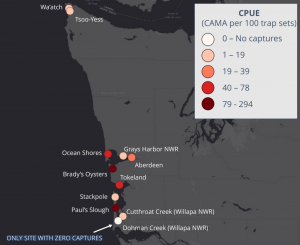
Relative abundance of green crabs across coastal Crab Team monitoring network sites in 2023. Click to enlarge
In the southwest estuaries of Grays Harbor and Willapa Bay, spatial distribution of patterns remained somewhat consistent with previous years. In the past, we’ve observed a clear trend with greater abundances concentrated near the mouths of the estuaries, where larvae will wash into the system and settle out at higher concentrations. We continue to observe that pattern in 2023 Crab Team monitoring network data: In Grays Harbor, Ocean Shores and Brady’s recorded the highest catch rates on average, and in Willapa Bay, Tokeland and Nahcotta followed that trend. However, encouragingly, catch rates were lower at half of those sites (Ocean Shores and Nahcotta) compared to previous years.
Low’s and No’s
In contrast to the newly trapped sites that we first mentioned, there were some sites that showed lower population trends, and some sites that still haven’t detected green crabs at all! Catch rates are generally down in places where heavy trapping has occurred for two or more years. The best examples of these are Stackpole on the Long Beach Peninsula in Willapa Bay, North Willapa sites such as Willapa Meadows and Reclamation, which are grounds that are consistently trapped by the Pacific County Invasive Species Management team, and Ocean Shores in Grays Harbor.
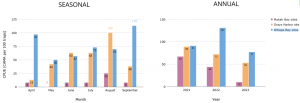
Seasonal (2023) and annual catch rates of European green crab in monitoring network efforts grouped by water body. Click to enlarge.
And there are even more wins to celebrate. The stretch from the Olympic Peninsula from La Push (trapped consistently by the Quileute Tribe) south until Copalis, no live green crab captures have yet been reported.
What Do These Numbers Mean?
Over the entire Washington geography, we see both promising signs and also a few looming questions. There are a significant number of sites where intensive and sustained trapping efforts appear to paying off in either reducing the density of crabs, or “fishing down” the size of crabs at the site. That is, the largest crabs are less frequent in the population. This is often a sign that harvest is changing the structure of a population, since harvest efforts generally tend to preferentially remove the larger, older individuals. In addition, we can see more support for the effect of trapping because nearby sites with less trapping the previous year have seen increases in catch rates (think Drayton Harbor vs. Birch Bay, where no trapping took place in 2022).
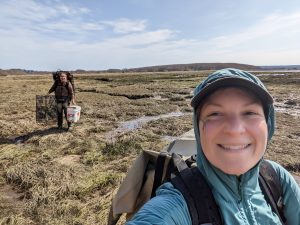
Coastal Specialist Alex Stote and Alexa Brown (WA Dept of Natural Resources), trapping intertidal channels in 2023. Photo: Alex Stote
The dynamics are not always so simple, however, in part because each year, additional larvae are arriving from other locations. While, thankfully, in 2023, we did not see huge pulses of young of the year (as we have in other years and locations), local differences in recruitment could explain why catch rates have gone up in a location where there is ongoing intensive trapping – Tokeland. Despite heavy control trapping efforts by the Shoalwater Bay tribe, overall capture rates appear to have still increased in 2023 relative to 2022. Being close to the mouth of Willapa Bay, this region may be particularly exposed to larvae being washed in from even larger populations outside Washington.
Thus, in addition to the motivation and resources for trapping, Washington relies on some help from nature to control green crab numbers. The past several years, the ocean conditions have been comparatively cool as part of La Niña climate and weather patterns. Researchers have observed that strong recruitment and dispersal years for green crabs are enhanced by warm waters (Yamada et al. 2021*), and indeed, in Washington, the years of relative green crab abundance and spread have nearly always coincided with El Niño years, going back to the first detection in the state in 1997/1998. It’s not lost on us that this is the first El Niño since 2015/2016, and thus it is possible that we could expect to see much stronger, earlier, and more widely dispersed, recruitment of green crab all throughout Washington in 2024.
Increasing cases of finding green crabs in more exposed habitat types where they were previously undetected is consistent with observation coast-wide, including Oregon coastlines. It is possible that, as green crab populations grow and and increase their range over the course of the invasion, they expand the breadth of types of habitat they use. Larger core populations make up for “losses” in habitats where green crabs might experience lower survival relatively. Other types of habitat where we don’t currently see many green crabs that might be impacted soon include eelgrass beds, a concern given evidence from the East Coast where green crabs are implicated in eelgrass damage and decline.
Which means that it’s good news that nearly everyone is already in their waders out in the mud with even more teams in training!
Thirsty for more?
- WDFW Invasive Species Awareness Week Webinar
- Crab Team Network Data Dashboard
- Crab Team infographic
- Molt Search reports
- WDFW EGC Info Hub
- WDFW EGC Public Updates
–Alex Stote and Emily Grason
Kudos to the extensive list of leader and contributors to these efforts: Washington Department of Fish and Wildlife, Washington Department of Natural Resources, Makah Tribe, Shoalwater Bay Tribe, Pacific County Invasive Species Management, Grays Harbor Conservation District, US Fish and Wildlife Service (GHNWR and WBNWR), shellfish growers, Willapa Bay Grays Harbor Oyster Growers Association, and of course the partner and volunteer monitors with the Crab Team monitoring network!
*While we try to link you directly to the research we reference, some of the studies cited in this article are not open access. If you have any questions about any of the works cited here, please feel free to reach out to crabteam@uw.edu.
MAY
2024